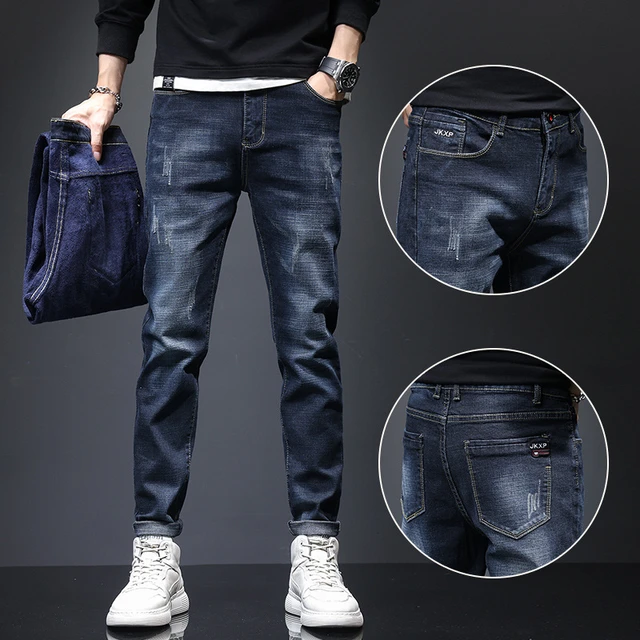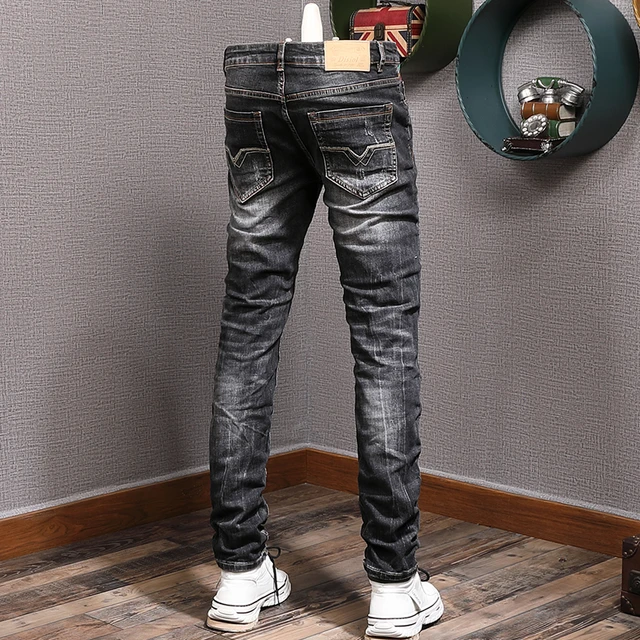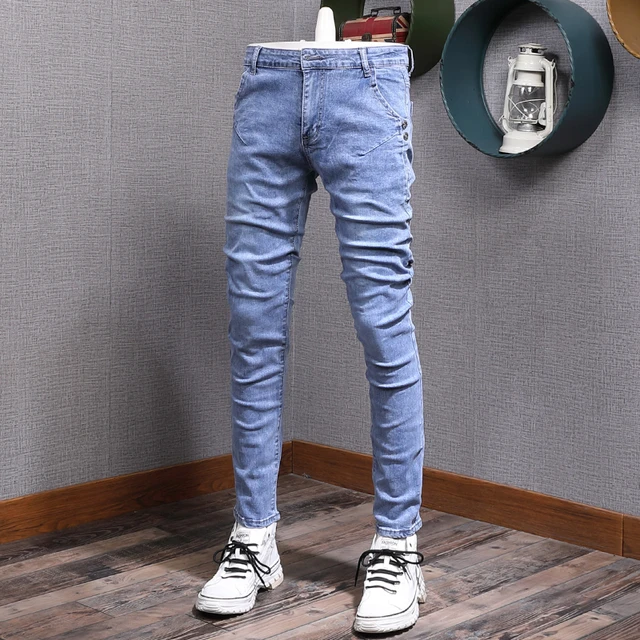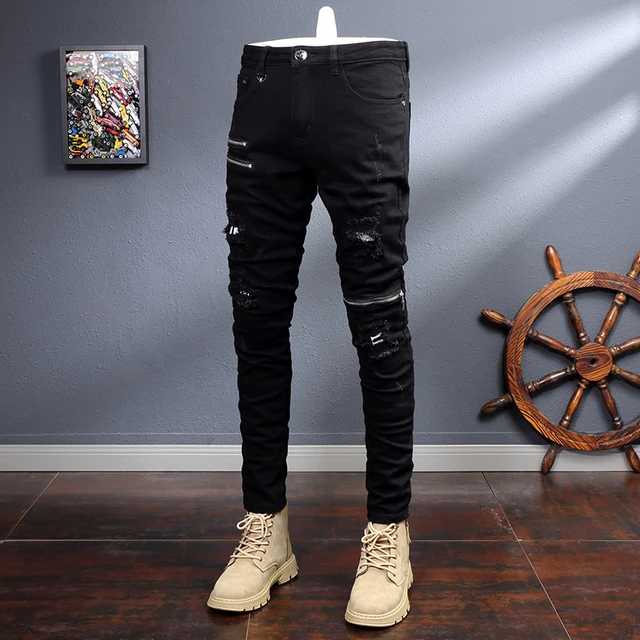Introduction:
Finding the right fit for men’s jeans is crucial for both comfort and style. Ill-fitting jeans can be uncomfortable and detract from your overall appearance. In this comprehensive article, we will explore the different aspects of how men’s jeans should fit. From waist and rise measurements to leg and seat considerations, we will provide simple and straightforward guidance to help you find the perfect fit for your denim.
Materials, Types, and Styles of Jeans:
Materials:
Denim: Denim is the primary material used in the production of jeans. It is a sturdy cotton twill fabric, typically woven in a diagonal pattern, which provides durability and strength. Denim can vary in weight, with heavier weights being more durable and suitable for colder weather, while lighter weights offer a more breathable and lightweight option.
Types of Denim Jeans:
Skinny Jeans: Skinny jeans are snug-fitting jeans that taper tightly from the waist to the ankle. They are popular for their sleek and form-fitting style.
Straight Leg Jeans: Straight leg jeans have a uniform width from the waist to the ankle, creating a straight, classic silhouette. They offer a versatile and timeless look.
Bootcut Jeans: Bootcut jeans are fitted through the thigh and knee, then slightly flare out towards the hem. They are designed to accommodate boots and provide a balanced and flattering look.
Flare Jeans: Flare jeans have a more pronounced and exaggerated flare at the hem, creating a retro-inspired style statement. They are wider at the knee and gradually widen towards the ankle.
Boyfriend Jeans: Boyfriend jeans have a relaxed and loose fit, reminiscent of jeans worn by men. They typically have a low waist and a straight or slightly tapered leg.
High-Waisted Jeans: High-waisted jeans have a higher rise and sit above the natural waistline. They offer a flattering fit and can elongate the legs.
Low-Rise Jeans: Low-rise jeans sit below the natural waistline, typically on the hips. They provide a more casual and youthful look.
Styles and Designs:
Washes: Denim jeans come in various washes, referring to the color and treatment applied to the fabric. Common washes include dark wash, light wash, acid wash, stone wash, and distressed wash. Each wash creates a unique aesthetic, ranging from clean and polished to worn and vintage-inspired.
Embellishments: Jeans can feature embellishments such as embroidery, patches, studs, or decorative stitching. These details can add visual interest and enhance the overall style of the jeans.
Ripped or Distressed: Ripped or distressed jeans have intentional tears, fraying, or abrasions that create a worn and edgy look. These styles add a touch of rebelliousness and a casual vibe to the jeans.
Cuts and Silhouettes: Beyond the basic types of jeans, there are various cuts and silhouettes available, such as cropped jeans, wide-leg jeans, or jeggings (a blend of jeans and leggings). These options cater to different body types and fashion preferences.
Denim jeans are made primarily from denim fabric, which offers durability and strength. Skinny jeans, straight leg jeans, bootcut jeans, flare jeans, boyfriend jeans, high-waisted jeans, and low-rise jeans are popular types of denim jeans, each with its own unique fit and style. Jeans come in different washes, ranging from dark to light, and may feature embellishments, distressing, or unique cuts and silhouettes. With a wide variety of options available, denim jeans offer versatility, comfort, and a timeless appeal that can be tailored to individual tastes and fashion preferences.
Waist Measurement:
The waistband of your jeans should sit comfortably around your natural waist, which is the narrowest part of your torso.
Avoid jeans that are too tight, as they can cause discomfort and restrict movement.
Similarly, avoid jeans that are too loose, as they may sag or fall down.
Rise Measurement:
The rise of your jeans refers to the distance between the crotch seam and the waistband.
Choose from different rise options, including low rise, mid-rise, and high rise, based on your personal preference and body shape.
Ensure that the rise is suitable for your comfort and provides adequate coverage without being too restrictive or baggy.
Leg Fit:
The leg fit of your jeans plays a crucial role in both comfort and style.
Slim Fit: Slim fit jeans offer a close-fitting silhouette from the waist to the ankle. They provide a modern and streamlined look for those who prefer a more tailored appearance.
Straight Fit: Straight fit jeans have a consistent width from the waist to the ankle. They provide a classic and versatile option that suits various body types and styles.
Bootcut Fit: Bootcut jeans are slightly wider at the ankle to accommodate boots. They are a popular choice for those who want a looser fit around their lower legs.
Relaxed Fit: Relaxed fit jeans provide a roomier and more comfortable fit, particularly around the thighs and calves. They are suitable for those who prefer a more casual and laid-back look.
Seat Fit:
The seat fit refers to how the jeans fit around your buttocks and hips.
Ensure that the jeans provide enough room for movement without being too tight or restrictive.
Avoid excess fabric or sagging, as this can affect the overall appearance and comfort of the jeans.
Length:
The length of your jeans is an important consideration for a polished look.
The hem should ideally graze the top of your shoes, creating a slight break or no break at the ankle.
Avoid excessively long jeans that bunch up or drag on the ground, as they can appear sloppy.
Tailoring:
If you cannot find jeans off-the-rack that fit perfectly, consider getting them tailored.
A professional tailor can customize the waist, leg length, or any other adjustments needed to achieve the ideal fit for your body.
Personal Comfort:
Ultimately, the fit of your jeans should be based on your personal comfort and style preferences.
Try on different styles, cuts, and sizes to find the fit that makes you feel confident and comfortable.
Conclusion:
Finding the right fit for men’s jeans is essential for both comfort and style. From the waist and rise measurements to leg and seat considerations, understanding how jeans should fit can help you choose the perfect pair. Remember to select a waistband that sits comfortably, choose a rise that suits your preferences, opt for a leg fit that matches your style, ensure a proper seat fit, and consider tailoring for a customized fit. By finding jeans that fit well, you can enhance your overall appearance and feel confident in your denim attire.




